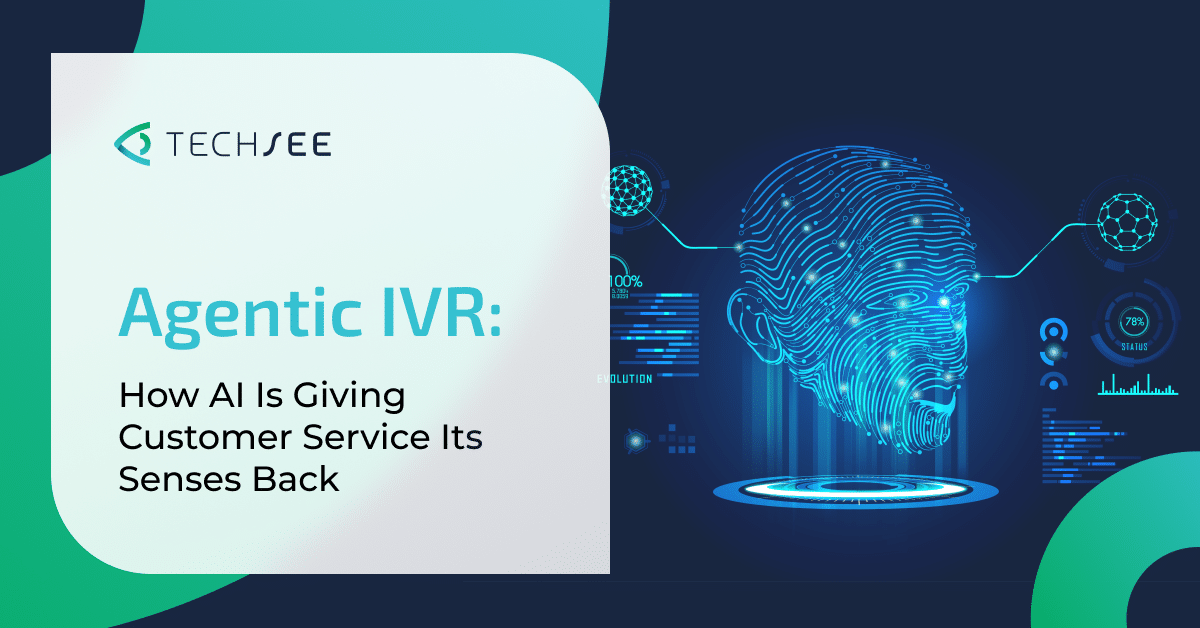Contents
- Agentic IVR: How AI Is Giving Customer Service Its Senses Back
Agentic IVR: How AI Is Giving Customer Service Its Senses Back
The phone channel has survived every wave of digital transformation. Even with the rise of apps, chatbots, and automated portals, most customers still reach for the phone when something matters. Yet what they find there has barely changed in decades: a maze of menus, static options, and long hold times.
Agentic AI is changing that. It is giving IVR something it has never had before: awareness, context, and the ability to act. Instead of just routing calls, the IVR can now think and respond, connecting data, intent, and customer history in real time. The result is a smarter, more human experience: one that listens, learns, and increasingly, even sees.
The IVR’s Untapped Opportunity
For many organizations, the IVR remains a cost to maintain rather than a capability to improve. Yet according to Gartner, 54% of customer journeys still start on the phone. Only 3% of those issues are actually resolved in the IVR, and most of those failures come from poor design or lack of intelligence.
That gap is a massive opportunity. The IVR is the front door of customer experience for most service organizations. When powered by AI IVR automation, it becomes a high-value digital asset capable of understanding intent, executing actions, and adapting to context without needing a live agent.
AI IVR transformation is redefining the traditional contact center experience. It turns a legacy touchpoint into an autonomous system that can guide, resolve, and even anticipate customer needs.
From Reactive to Agentic
Traditional IVR systems are reactive. They wait for customers to make a selection and respond with predefined options. Agentic IVR systems are proactive. They detect intent, plan actions, and execute workflows.
They understand what customers say and what they mean. This new model combines natural language processing (NLP) understanding, reasoning, and orchestration. The system listens, interprets, and takes action in real time.
It can authenticate a customer, initiate a workflow, send an update via text, and seamlessly transfer context to an agent when needed. An Agentic AI voice bot resolves them through reasoning and AI IVR workflow automation instead of just deflecting them.
How Agentic IVR Works
An IVR AI agent acts like an intelligent teammate within the contact center environment. It performs a sequence of cognitive tasks that mirror how a human service agent thinks and acts:
- Understand: Identify customer intent using conversation analysis and context data.
- Plan: Choose the best course of action, whether that’s verification, information retrieval, or self-resolution.
- Act: Execute workflows, trigger system updates, or connect to digital tools.
- Adapt: Learn from results and refine future decisions based on success or failure.
This creates a continuous feedback loop where every interaction improves the next one. Over time, the IVR becomes faster and smarter. It functions as an autonomous IVR agent that enhances service efficiency.
Building Smarter IVR Experiences
A successful Agentic IVR strategy depends on four principles that define how AI and customers interact:
- Consent: Customers choose whether to stay in voice, move to chat, or access digital self-service.
- Context: The system transfers all previously collected data to prevent repetition.
- Choice: It only offers self-service paths where automation success rates are high.
- Conditions: AI adjusts dynamically based on traffic, issue type, or urgency.
Together, these principles turn the IVR into a living, context-aware IVR AI system. One that manages customer effort and adapts its behavior like an experienced human representative.
Operational Impact
Agentic IVR systems are delivering measurable operational improvements across industries. They can authenticate customers before an agent joins, collect structured data for faster routing, and update records automatically.
Each of these steps saves time on the call and lowers the cost per contact. AI-powered IVR can reduce average handle time and improve containment. It allows agents to start conversations already armed with relevant context. The result is higher productivity for service teams and less frustration for customers.
Agentic IVR also supports hybrid journeys. A customer might start with a voice conversation, receive an SMS link to complete a form, and return to the same IVR session for confirmation, all without losing context. This fluidity creates a unified customer experience across channels.
The Next Step: Adding Vision to IVR
The next frontier for Agentic IVR is adding visual AI in customer service. Once the system can see as well as hear, it becomes capable of solving an entirely new class of problems.
By incorporating multimodal intelligence, the IVR can analyze photos or videos shared during the call. A customer can show what’s wrong instead of explaining it. The system uses visual intelligence to recognize devices, read serial numbers, detect indicator lights, or identify physical setup issues.
This capability transforms waiting time into resolution time.
Examples include:
- Telecom: A customer waiting on hold uploads a router photo. The AI identifies LED patterns and guides the customer through a fix.
- Utilities: A customer submits a photo of a meter reading, and the system confirms it automatically.
- Consumer electronics: The AI identifies missing components or incorrect setups and offers step-by-step corrections.
If human assistance is still required, the agent receives all this visual context before joining. That means fewer questions, shorter calls, and more first-time resolutions. By adding vision, the IVR becomes truly multimodal, able to process what customers say and show, creating interactions that feel more natural and human.
Why Service Leaders Should Care
Agentic IVR represents more than an incremental upgrade. It’s a redefinition of how automation interacts with people. Instead of being a gatekeeper, the IVR becomes a guide capable of understanding intent, solving problems, and preparing humans with richer context when needed.
Organizations using AI in call center operations report significant improvements in average handle time, customer satisfaction, and agent productivity. The IVR can now serve as a seamless extension of an AI voice agent platform, ensuring that every handoff between human and machine feels natural and efficient.
The combination of Agentic reasoning and multimodal sensing is what will finally close the gap between customer frustration and effortless resolution. For service leaders, it’s the start of a more perceptive, responsive, and intelligent customer experience.
Frequently Asked Questions: AI Call Center Automation
What is an Agentic IVR?
An Agentic IVR is an AI-powered system that can understand intent, plan actions, and execute workflows autonomously. It goes beyond routing calls to actually resolving issues using reasoning and automation.
How do AI voice bots fit into Agentic IVR?
AI voice bots act as the interactive layer within an Agentic IVR. They interpret natural language, guide customers through steps, and collaborate with backend systems to complete tasks such as registration, updates, or troubleshooting.
What are the benefits of Agentic IVR?
Agentic IVR improves containment, shortens handling time, and reduces customer effort. It gives agents richer context and allows organizations to handle more interactions with fewer resources.
How does adding vision improve IVR performance?
Visual input lets the AI see what the customer sees. It can recognize devices, detect problems, and suggest fixes before a person gets involved. This helps customers resolve issues faster and gives agents valuable context when they step in.
Where should companies start?
Organizations should begin by automating routine call intents that follow predictable patterns, such as authentication or order status. Once data collection and workflows are stable, they can be extended to include multimodal capabilities such as image recognition or guided visual troubleshooting.






